
The Phaethontiformes are an order of birds. They contain one extant family, the tropicbirds (Phaethontidae), and one extinct family Prophaethontidae from the early Cenozoic. Several fossil genera have been described.

Neoaves is a clade that consists of all modern birds with the exception of Paleognathae and Galloanserae. Almost 95% of the roughly 10,000 known species of extant birds belong to the Neoaves.

Aequornithes, or core water birds are defined as "the least inclusive clade containing Gaviidae and Phalacrocoracidae".
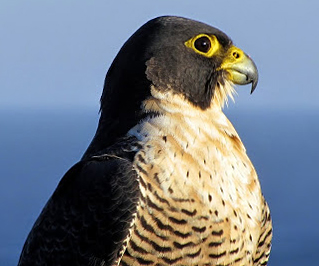
The order Falconiformes is represented by the extant family Falconidae and a handful of enigmatic Paleogene species. Traditionally, the other bird of prey families Cathartidae, Sagittariidae (secretarybird) Pandionidae (ospreys), Accipitridae (hawks) were classified in Falconiformes. A variety of comparative genome analysis published since 2008, however, found that falcons are part of a clade of birds called Australaves, which also includes seriemas, parrots and passerines. Within Australaves falcons are more closely related to the parrot-passerine clade (Psittacopasserae), which together they form the clade Eufalconimorphae. The hawks and vultures occupy a basal branch in the clade Afroaves in their own clade Accipitrimorphae, closer to owls and woodpeckers.

Strisores is a clade of birds that includes the living families and orders Caprimulgidae, Nyctibiidae (potoos), Steatornithidae (oilbirds), Podargidae (frogmouths), Apodiformes, as well as the Aegotheliformes (owlet-nightjars) whose distinctness was only recently realized. The Apodiformes and the Aegotheliformes form the Daedalornithes.

Australaves is a recently defined clade of birds, consisting of the Eufalconimorphae as well as the Cariamiformes. They appear to be the sister group of Afroaves. As in the case of Afroaves, the most basal clades have predatory extant members, suggesting this was the ancestral lifestyle; however, some researchers like Darren Naish are skeptical of this assessment, since some extinct representatives such as the herbivorous Strigogyps led other lifestyles. Basal parrots and falcons are at any rate vaguely crow-like and probably omnivorous.
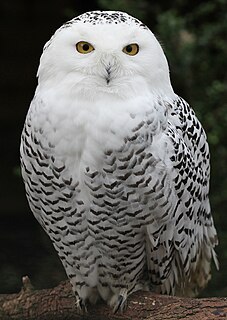
Afroaves is a clade of birds, consisting of the kingfishers and kin (Coraciiformes), woodpeckers and kin (Piciformes), hornbills and kin (Bucerotiformes), trogons (Trogoniformes), cuckoo roller (Leptosomiformes), mousebirds (Coliiformes), owls (Strigiformes), raptors (Accipitriformes) and New World vultures (Cathartiformes). The most basal clades are predatory, suggesting the last common ancestor of Afroaves was also a predatory bird.

Telluraves is a recently defined clade of birds defined by their arboreality. Based on most recent genetic studies, the clade unites a variety of bird groups, including the australavians as well as the afroavians. They appear to be the sister group of the Ardeae.

Columbea is a clade suggested by genome analysis that contains Columbiformes, Pteroclidae (sandgrouse), Mesitornithidae (mesites) and Mirandornithes. Until their recent placement as the sister taxon to Passerea, in the last decade various genetic analysis found them to be in the obsolete clade Metaves.

Eurypygimorphae or Phaethontimorphae is a clade of birds that contains the orders Phaethontiformes (tropicbirds) and Eurypygiformes recovered by genome analysis. The relationship was first identified in 2013 based on their nuclear genes. Historically these birds were placed at different parts of the tree, with tropicbirds in Pelecaniformes and the kagu and sunbittern in Gruiformes. Some genetic analyses have placed the eurypygimorph taxa in the controversial and obsolete clade Metaves, with uncertain placement within that group. More recent molecular studies support their grouping together in Eurypygimorphae, which is usually recovered as the sister taxon to Aequornithes within Ardeae.
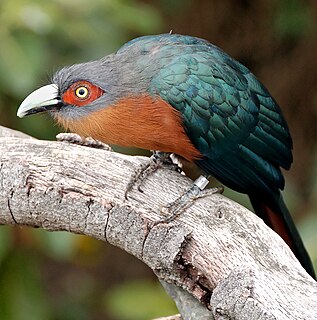
The Otidimorphae is a clade of birds that contains the orders Cuculiformes (cuckoos), Musophagiformes (turacos), and Otidiformes (bustards) identified in 2014 by genome analysis. While the bustards seem to be related to the turacos, other genetic studies have found the cuckoos to be closer to the bustards than the turacos are.
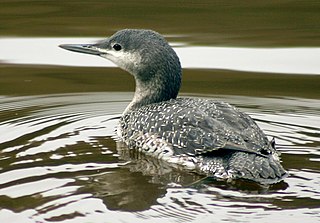
Phaethoquornithes is a clade of birds that contains Eurypygimorphae and Aequornithes, found in 2014 by genome analysis. Members of Eurypygimorphae were originally classified in the obsolete group Metaves, and Aequornithes were classified as the sister taxon to Musophagiformes or Gruiformes.

Coraciimorphae is a clade of birds that contains the order Coliiformes (mousebirds) and the clade Cavitaves. The name however was coined in the 1990s by Sibley and Ahlquist based on their DNA-DNA hybridization studies conducted in the late 1970s and throughout the 1980s. However their Coraciimorphae only contains Trogoniformes and Coraciiformes.

Eucavitaves is a clade that contains the order Trogoniformes (trogons) and the clade Picocoraciae. The name refers to the fact that the majority of them nest in cavities.

Accipitrimorphae is a clade of birds of prey that include the orders Cathartiformes and Accipitriformes. However, this group might be a junior synonym of Accipitriformes. The DNA-based proposal and the NACC and IOC classifications include the New World vultures in the Accipitriformes, but the SACC classifies the New World vultures as a separate order, the Cathartiformes which has been adopted here. The placement of the New World vultures has been unclear since the early 1990s. The reason for this is the controversial systematic history of the New World vultures as they were assumed to be more related to Ciconiidae after Sibley and Ahlquist work on their DNA-DNA hybridization studies conducted in the late 1970s and throughout the 1980s. The stork-vulture relationship has seemed to not be supported. Regardless of whether to use Accipitrimorphae or Accipitriformes, these birds belong to the clade Telluraves.
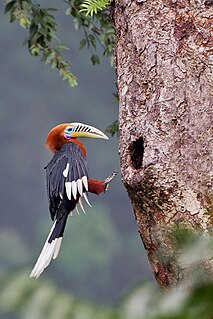
Cavitaves is a clade that contain the order Leptosomiformes and the clade Eucavitaves. The name refers to the fact that the majority of them nest in cavities.

Picocoraciae is a clade that contains the order Bucerotiformes and the clade Picodynastornithes supported by various genetic analysis and morphological studies. While these studies supported a sister grouping of Coraciiformes and Piciformes, a large scale, sparse supermatrix has suggested alternative sister relationship between Bucerotiformes and Piciformes instead.

Columbimorphae is a clade discovered by genome analysis that includes birds of the orders Columbiformes, Pterocliformes (sandgrouse), and Mesitornithiformes (mesites). Previous analyses had also recovered this grouping, although the exact relationships differed. Some studies indicated a sister relationship between sandgrouse and pigeons while other studies favored a sister grouping of mesites and sandgrouse instead.

Columbaves is a clade that contains Columbimorphae and Otidimorphae discovered by genomic analysis by Prum et al. (2015). This conflicts with the Columbea and Otidae hypotheses which Mirandornithes are the sister taxon to Columbimorphae and Cypselomorphae the sister taxon to Otidimorphae, respectively, found by Jarvis et al. (2014). Neither hypothesis supports the two subdivisions of Metaves and Coronoaves as previous studies had found.

Aequorlitornithes is a clade of waterbirds recovered in a comprehensive genomic systematic study using nearly 200 species in 2015. It contains the clades Charadriiformes, Mirandornithes and Ardeae. Previous studies have found different placement for the clades in the tree.




















